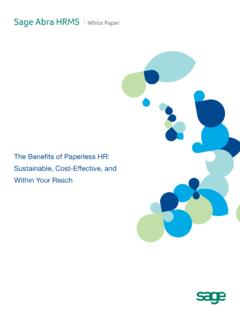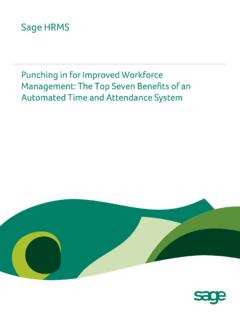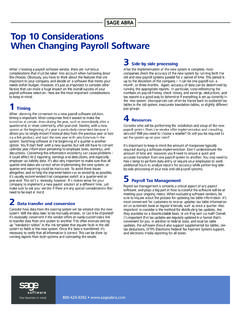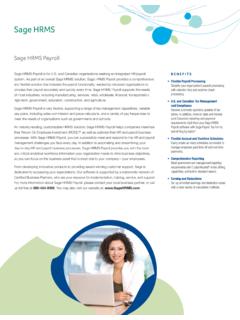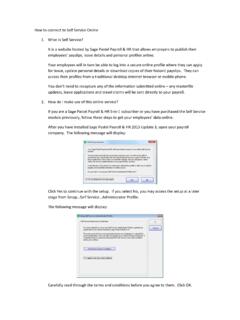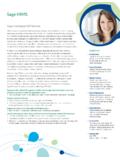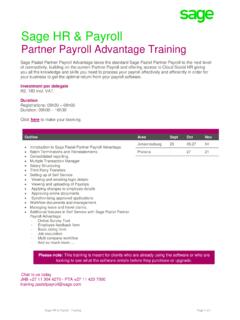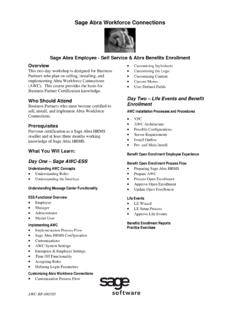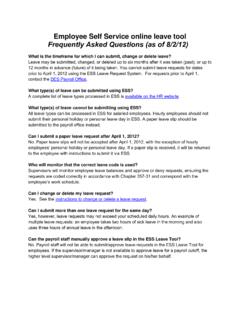Transcription of Sage HRMS I Planning Guide - Dresser & Associates
1 sage hrms I Planning Guide15 Factors to Consider When ChangingHow You Process PayrollSage HRMST able of ContentsIntroduction ..1 Starting Your Evaluation ..1 1. Timing 2. Evaluation TeamFunctional Requirements ..2-3 3. Payroll Tax Management and Reporting 4. Security 5. Payment Flexibility 6. employee self -Service 7. Integration CapabilitiesVendor Considerations ..4-5 8. Vendor Stability and Track Record 9. Customer Support 10. Local Support 11. ReferencesImplementation Planning ..5-6 12. Hardware 13. Data Transfer and Conversion 14.
2 Implementation Resources 15. Side-By-Side ProcessingConclusion ..6 sage HRMSI ntroductionWhen changing how you process payroll, there are numerous considerations that must be taken into account. You will want to think about the features that are important to your company and decide on a solution that meets your needs within budget. The key to selecting the right payroll solution for your organization is to make certain that all of the vendors you evaluate can meet your needs before you begin to narrow down your choices. As you gather requirements and create your Request for Proposal (RFP), you ll need to consider the functional capabilities required to produce accurate payroll, the vendor qualities you value most, and finally, how you plan to implement a new solution.
3 Here are 15 factors to keep in mind:Starting Your Evaluation 1. Timing When Planning the conversion to a new payroll software solution, timing is important. Most companies find it easiest to make the transition at certain times during the year, such as immediately after a quarter-end or, more commonly, after year-end. Starting with a new system at the beginning of a year is particularly convenient because it allows you to simply import employee demographic and setup data, and start the new year with zero balances in the system.
4 Switching software at the beginning of a quarter is another option. You ll start fresh with a new quarter but will still have to convert calendar year information pertaining to employee taxes, earnings, and deductions. Converting this information incorrectly can cause problems it could affect W-2 reporting in the , or T4/Releve 1 reporting in Canada, as well as earnings and deductions, and especially employer tax liability data. It s also very important to make sure that all quarter-end dates are correct when implementing the new system, or quarter-end reporting could be inaccurate.
5 To avoid these issues altogether, and to help the implementation run as smoothly as possible, it s usually recommended that companies switch at a quarter-end or year-end. This isn t a necessity, however. If it makes sense for your company to implement a new payroll solution at a different time, just make sure to ask your vendor if there are any special considerations that need to be kept in Evaluation Team One of the most important decisions early in the process of selecting a new payroll system is putting together the team who will help you evaluate your options.
6 Make sure that your team includes someone from every department that is a stakeholder in the payroll process. That may include representatives from human resources (HR), information technology (IT), accounting, and the executive team. When you select the right team, you ll be assured that you have all the buy-in you need when it is time to purchase and implement the new payroll HRMSF unctional Requirements3. Payroll Tax Management and Reporting Payroll tax management is certainly a critical aspect of any payroll software, and plays a big part in how successful the software will be at meeting your ongoing needs.
7 When evaluating software vendors, be sure to inquire about the process for updating tax table information It s most convenient for customers to receive updated tax table information on an automatic basis at regular intervals, such as once a quarter. Also important to consider is the method for distributing tax updates. Are they available on a downloadable basis, or are they sent by mail? Overall, it s important that tax updates are regularly updated in a format that s convenient for you. In addition to federal, state/provincial, and local tax table updates, the software should also support supplemental tax tables, pretax deductions, EFTPS (Electronic Federal Tax Payment System) and EFT (Electronic File Transfer) support, and electronic media reporting for all Security Payroll systems contain extremely sensitive employee data, including social security numbers and financial information.
8 Because many employees prefer to be paid on payroll cards or by direct deposit, your payroll software will have employee bank account numbers, as well as banking information for your company s payroll accounts. It is absolutely essential that any payroll solution you select be protected by a comprehensive yet easy-to-configure security system. Rules should govern who can see, modify, approve report, or otherwise access information and no unauthorized person should be able to obtain Payment Flexibility Your employees have different financial needs and goals.
9 Offering them flexible payment methods empowers them to better manage their finances and also affords your company the opportunity to save on payroll costs. Direct deposit and payroll cards both cost much less than printing paper paychecks. These methods also reduce the risk of check fraud and eliminate the cost of cancelling and reissuing lost or stolen paper checks. The ability to support all three types of payment allows your organization to be much more flexible and effective on employee self -Service A paycheck is an employee s most important benefit, so it s not surprising that payroll generates a lot of employee questions.
10 employee self -service (ESS) functionality that integrates to your payroll system can enable employees to review their payroll history and access their paystubs. Choosing a system that supports ESS can help employees find the information they need about payroll on their own and reduce the volume of questions coming into the payroll or HR HRMSF unctional Requirements7. Integration Capabilities It s important to think about the ability of the payroll software to integrate to your existing human resource management system ( hrms ) and general ledger software, in addition to any other related applications, such as timekeeping or business intelligence systems.
